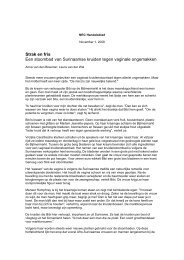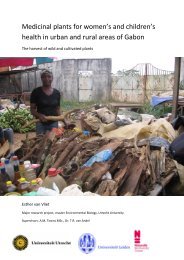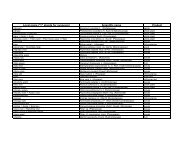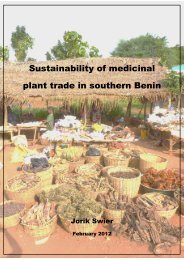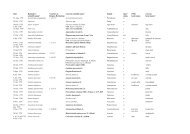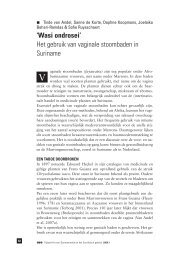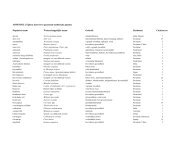T. Heilbron 2012.Botanical relics of the plantations - osodresie
T. Heilbron 2012.Botanical relics of the plantations - osodresie
T. Heilbron 2012.Botanical relics of the plantations - osodresie
Create successful ePaper yourself
Turn your PDF publications into a flip-book with our unique Google optimized e-Paper software.
Lastly, in trying to determine age, historical sources such as plantation maps, pictures and<br />
manuscripts containing detailed information on a particular plantation can be useful as well,<br />
although maps that depict individual plants on (part <strong>of</strong>) a plantation are scarce.<br />
Once sufficient knowledge on botanical <strong>relics</strong> is accumulated, <strong>the</strong> human influences in<br />
seemingly natural forest in overgrown <strong>plantations</strong> can be found and understood.<br />
4.4 Tracking plants<br />
In <strong>the</strong> literature some <strong>of</strong> <strong>the</strong> encountered species can be tracked and some information on <strong>the</strong>ir<br />
connection to <strong>the</strong> <strong>plantations</strong> can be found. For example, Rolander (2008) notes seeing a date<br />
palm in his diary (probably Phoenix reclinata (Van Andel et al., 2012), although he is unaware<br />
<strong>of</strong> <strong>the</strong> African origin <strong>of</strong> <strong>the</strong> palm. More than 200 years later, records <strong>of</strong> Phoenix reclinata by<br />
Ostendorf (1962) and Wessels Boer (1965) are made, and <strong>the</strong> African origin <strong>of</strong> <strong>the</strong> palm is noted.<br />
Currently, ano<strong>the</strong>r 50 years later, <strong>the</strong> palm has managed to become a part <strong>of</strong> natural vegetation,<br />
as shown in this research. Some o<strong>the</strong>r examples are <strong>the</strong> use <strong>of</strong> Trichan<strong>the</strong>ra gigantica as a<br />
windbreaker for juvenile cacao trees and a Pandanaceae species (Pandanus tectorius Parkinson<br />
ex Du Roi) brought from Java in <strong>the</strong> 1910s Ostendorf (1962). However, for o<strong>the</strong>r species and<br />
<strong>the</strong>ir connection to <strong>the</strong> <strong>plantations</strong> much is unknown. For example Triphasia trifolia, still used<br />
as a hedge plant in Suriname (e.g. at <strong>the</strong> presidential palace in Paramaribo), was unknown as a<br />
relic <strong>of</strong> <strong>the</strong> <strong>plantations</strong> and questions on its connection to <strong>the</strong> <strong>plantations</strong> in Suriname remain.<br />
4.5 Prospects <strong>of</strong> botanical <strong>relics</strong><br />
Surinamese citizens are generally interested in plantation history, both in urbanized environments<br />
as well as rural communities. People <strong>of</strong> all ethnic groups in Suriname possess knowledge<br />
on a variety <strong>of</strong> plants and <strong>the</strong>ir uses. Still, botanical heritage is viewed somewhat different, as<br />
people are mostly unaware <strong>of</strong> <strong>the</strong> historical connections between certain plants, <strong>the</strong> <strong>plantations</strong><br />
and <strong>the</strong> country’s history. The physical botanical heritage is not always seen as valuable, as <strong>the</strong><br />
cutting <strong>of</strong> <strong>the</strong> ancient tamarind lane on plantation Alliance demonstrates. Also, <strong>the</strong> government<br />
appears to be doing little to protect this part <strong>of</strong> <strong>the</strong> country’s heritage. Private initiatives and<br />
non governmental organizations prove that interest exists to integrate protection <strong>of</strong> <strong>the</strong> heritage<br />
into <strong>the</strong> country’s policy. Apart from raising historical and environmental awareness among<br />
Surinamers, <strong>the</strong> protection <strong>of</strong> <strong>the</strong> botanical heritage <strong>of</strong> <strong>the</strong> <strong>plantations</strong> could provide economic<br />
opportunities for (eco)tourism.<br />
4.6 Follow-up research<br />
In a brief fieldwork period part <strong>the</strong> botanical heritage <strong>of</strong> <strong>the</strong> <strong>plantations</strong> in Suriname was revealed<br />
and documented, but surely <strong>the</strong>re is much more to be found. Some potential <strong>relics</strong> mentioned<br />
in <strong>the</strong> literature, such as Sesamum indicum and Elaeis guineensis (Ostendorf, 1962), Indig<strong>of</strong>era<br />
tinctoria, Cleome gynandra (Van Andel et al., 2012) and Oryza glaberrima (Van Andel, 2010)<br />
were not found during this study, but are known to occur and be used elsewhere in Suriname<br />
(Van Andel & Ruysschaert, 2011). O<strong>the</strong>r leads remain to be investigated, for example <strong>the</strong> ‘loweman<br />
bakba’ encountered wild in <strong>the</strong> forest by early contract workers, and <strong>the</strong> apparent cultivation<br />
17



